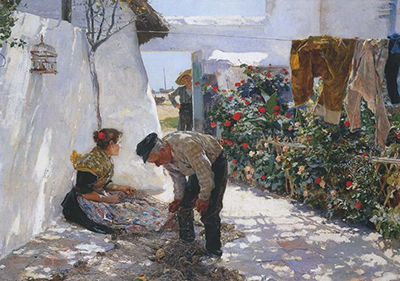 Buy Art Prints Now
Buy Art Prints Nowfrom Amazon
* As an Amazon Associate, and partner with Google Adsense and Ezoic, I earn from qualifying purchases.
The beaches of Valencia would provide a huge resource of inspiration for Joaquin Sorolla, with these attractive locations serving as a hub for the local community. He would capture a wide variety of activities including children playing in the water and hard working fishermen bringing in their catches.
The artist would produce a number of paintings within the genre of social realism earlier in his career, such as poor people travelling by train. He enjoyed this reflection on the lives of the ordinary but would later prefer to focus on the lives of fishermen, as this would allow a brighter palette of colour and was also a significant part of life in his native Valencia. Normally he would produce portraits of them at sea or around the beach area, meaning this painting titled Fishing Nets is a slight diversion from the norm. He loved to capture the balance of man and nature, with some artworks even feature animals alongside, normally from cattle dragging these vessels across the beach. He would also later include fisherwomen who themselves played an important part in this ecosystem that no doubt had been continuing down generations for many years and likely still exists in much the same capacity today.
Why does this particular artwork differ in terms of how Sorolla captures the fishing industry within Valencia? The painting itself, Fishing Nets, was completed in 1893 which makes it relatively early as compared to most of his beach-based artworks. It may have been that he was transitioning from his spell of social realism by capturing these two figures attempting to mend and tidy their fishing nets. The artist was clearly already intrigued by their everyday lives, but later on perhaps understood that he could use the beach and waves to insert bright colours and lift these compositions to a new level. That said, this unique work features some beautiful additions which underlines the artist's ability to produce incredibly subtle variations of colour which would ultimately make many of his paintings reach almost a photo-realistic level of accuracy. See other fine examples of his work, such as Women Walking on the Beach (Paseo a orillas del mar), Sewing the Sail and Sad Inheritance.
Sorolla was a particularly subtle artist who loved to produce extraordinary numbers of variations of the same colour which helped to make many of his paintings incredibly lifelike. That is why he would sometimes use huge canvases in order to maximise his level of detail, but in most cases his beach paintings would be delivered in a more standard sized format. The way in which the light would impact each and every object in his paintings would fascinate him, and his level of precision would also make him similar in approach to many of the French Impressionists. Those of us who have been fortunate enough to spend time in the beautiful country of Spain will find many of his artworks familiar in terms of the incredible saturation of light, and the way in which that would bring out an abundance of colour which has helped Sorolla to become one of the finest Spanish artists of all time, and someone who continues to be applauded and studied by new generations again and again.



